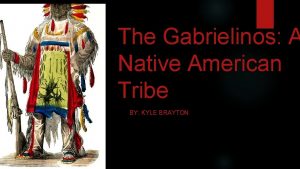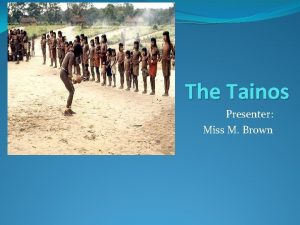FACTOR 1 HOMES FACTOR 2 ORGANISATION FACTOR 3






















- Slides: 22

FACTOR 1: HOMES FACTOR 2: ORGANISATION FACTOR 3: RELIGION FACTOR 6: HORSES How did the Indians survive on the Great Plains? FACTOR 5: WARFARE FACTOR 4: BUFFALO

Early Migration PUSH or PULL PUSH FACTOR: A negative event that is ‘pushing’ the white settlers to leave the east. PULL FACTOR: A positive reason that would attract the white settlers to the west. 1. The Economy in the East. People had lost jobs and savings, unemployment was high. Wages had been cut. 2. Better farmland in Oregon. Rich farmland to the west of the Rocky Mountains. 3. The Oregon Trail. First publicised by Smith in 1825. Slowly used more. By 1843, 900 people had used it. 4. Manifest Destiny. For many Americans, it was their God-given duty to spread civilisation across the continent. 5. US Government Encouragement. 1842 Pre -Emption Act where settlers could stake a claim. 6. Collapse in cereal prices. Many farmers were left in ruin and there was also overcrowding. 7. The Gold Rush. People left the east hoping to find gold and get rich. 8. Negotiation with Britain. Oregon became part of the United States in 1846 which made it more attractive. PREPARATIONS and PROBLEMS Preparations Potential Problems

E a r l y M i g r a t i o n Donner Party Mormons Problems and Solutions for Early Settlers

E a r l y Donner Party Led by Donner brothers. Left in May 1846 with 60 wagons at 300 people. More women, elderly and children than normal. Fort Bridger – 80 people tried to take a ‘short cut’ Arrived in Sierra Nevada and trapped by snow. Group sent for help took a long time. Both groups ate their dead. Rescue parties found in Jan 1847. Mormons M i g r a t i o n Joseph Smith was original leader and got a large following but was murdered in 1844. Brigham Young took over as leader. Faced persecution and believed they should move to the Great Salt lake. Everyone was split into groups, given a specific role and he insisted on regular rests. They also used an advance party. Between 1847 and 1869, 70, 000 Mormons followed the trail. Once in Salt Lake – used their faith, church-owned land, irrigation systems, helped others to move. KEY DATES IN CASE OF NARRATIVE. 1845 JS murdered. Young wanted to leave spring of 1846 – hostility forced them to move in Feb. Met at Omaha. Stayed until following spring. April 1847 – set off. Advance party reached July 1847, second group arrived August 1847. Problems and Solutions for Early Settlers PROBLEMS – climate, grasshoppers, lack of trees, thick sod, prairie fires, lack of water. EARLY SOLUTIONS – sod houses, burnt buffalo chips. Wells but were expensive and hard work. Ploughs would break so had to do by hand or get in professional ‘sod buster. ’

Potential Questions… Explain the importance of the buffalo to the way of life of Plains Indians. Explain the importance of horses to the way of life of Plains Indians. Explain the importance of warrior societies to Plains Indian life. Explain the importance of planning for migration along the Oregon Trail. Explain the importance of the Oregon Trail for the early settlement of the west. Explain the importance of the Gold Rush for the settlement of the West. Explain the importance of the leadership of Brigham Young to the successful settlement of the valley of the Great Salt Lake by the Mormons. Explain two consequences of the setting up of the Oregon Trail in 1836. Explain two consequences of the climate/lack of water/lack of trees on the white settlers’ ability to farm land on the Great Plains. Explain two consequences of the discovery of gold in California. Write a narrative account analysing why Americans went west in the years 1836 -49. You may use the following in your answer: - The Oregon Trail from 1836 - The California Gold Rush 1849 You must also use information of your own.

The Development of the Plains US Civil War In 1861, seven _____ states left the USA and set up their own ______, which triggered the ______ War. After 4 years, the Union _______ the Confederacy and they re-joined. Over ______ Americans had died and many southern states were left _____ by the war. The US government had to set about ________ the USA. The economic problems and social changes led to many people wanting to start a new life in the _______, most ex-soldiers and former _________. west defeated southern devastated confederacy slaves 600, 000 Civil rebuilding Homestead Act Achievements Limitations Timer Culture Act What did the Act allow? Why were trees important? How had this helped by 1878? Why was the Act criticised? Later on, the Timber Culture Act of 1873 was a correction to the Homestead Act.

• It cost just $10 to register a claim • Rich landowners used it to get land very cheaply eg get employers to file claims over an area • Ensured that places were being settled for the first time – eventually 80 million acres – massive success in Nebraska • Anyone could file a claim as long as they were over 21, including slaves and single women • 80 million acres was actually only 16% of public land • Encouraged immigration from Europe • By 1876, over 6 million acres of land had become Homesteads • Plots were 160 acre Homesteads • Had to live and work on land themselves and limits on how many claims one person could have • 60% were never proved up due to hard farming conditions • Only 13 million acres had been ‘proved up’ by 1884 • Lived on for 5 years, built a house, had crops – could pay to own outright – ‘proving up’

The Development of the Plains Pacific Railroad Act • • Two main problems against building before 1862 – enormous difficulty of building a 2000 km railroad and second, disagreement between north and south The Act was the result of southern states leaving the Union, which meant Federal government was in control of Northern states The Act split up the job of building the First Transcontinental Railroad between 2 companies – Union Pacific and Central Pacific The Act committed the government to extinguishing rights of Plains Indians along the route; loaning each company $16, 000 for every mile of track; granting each company large sections of public land In all, companies were given 45 million acres of free land loaned over $61 million However, both companies nearly went bust! Railroad companies use marking to encourage settlers to buy land – laid on trips and sent successful settlers to recruit others By 1880, railroad companies had settled 200 million acres Impact of Railroads? Homesteading in the 1870 s 1854 ‘self-governing’ windmill; 1870 steel blades What was it for? Advantages Limitations 1874 barbed wire 1875 sulky plow

The Development of the Plains Homesteading 1876 -95 Exoduster Movement 1879 and the Oklahoma Land Rush 1893 • • • • This event happened because of the oppression of black Americans after the Civil War Benjamin Singleton was the man who pioneered the move to Kansas White settlers had been trying to move to Indian Territory since the start of the 1880 s, but had been stopped After the Dawes Act in 1887, any land not used was put up for general sale The move was promoted at meetings and in newspaper adverts Rumour spread that the federal government had given the whole of Kansas to ex-slaves; this wasn’t true, but the rumour gave an incentive for them to move In 1889, the US government opened up the whole middle section of Indian territory, in 160 -acre sections By end of 1879, 40, 000 had set off west They got their name because of the move to the dry, dusty west Some other individuals such as Henry Adams were also important Many waited on the boundary and then rushed over once the signal was given The impact included the fact that by 1880, over 40, 000 black Americans were settling in Kansas; the fact that it was difficult as a lot of the good land had gone; a lot of them got ill through diseases such as yellow fever There were 7 land rushes in total between 1889 and 1895 – the biggest was in 1893 when 8 million acres was opened up The movement ended when they realised the reality of the situation – from 1880 s, much smaller numbers

Exam Questions Explain two consequences of the Homestead Act. Explain two consequences of the completion of the first transcontinental railroad in 1869. Explain two consequences of the introduction of barbed wire. Explain the importance of the railroad to migration west. Explain the importance of the railroad to the way of life of Plains Indians. Explain the importance of the railroad to the cattle industry. Explain the importance of the Homestead Act for the settlement of the west. Explain the importance of the leadership of Brigham Young to the successful settlement of the Salt Lake valley by the Mormons. Write a narrative account analysing the ways in which settlement in the West developed in the years 1876 -95. You may use the following in your answer: The Exoduster Movement 1879, The Oklahoma Land Rush 1893. You must also use information of your own. Write a narrative account analysing the ways in which homesteaders solved the problems of farming on the Great Plains in the years 1862 -76. You may use the following in your answer: the development of the railroads, the invention of barbed wire. You must also use information of your own.

Lawlessness Problems of Law and Order in early towns and settlements The California Gold Rush encouraged migration on a huge scale. Camps grew from nothing to thousands of people. There was also a lot of immigration. This created problems such as: 1. 2. 3. 4. 5. FEDERAL LAW ENFORCEMENT Only when a territory had population of 60, 000 could it apply to be a state. So the federal government decided on laws for each territory. It appointed a governor for the territory, 3 judges and a US Marshal (police officer. ) At a local government level, once a territory had a population of 5000, they could also elect a sheriff. They would have a two-year period of office. PROBLEMS: 1. 2. 3. Problems of Law and Order in the 1860 s - 1870 s A number of factors contributed to continuing crime. Lots of people owned weapons. There were rivalries between different groups. Immigrants caused social tension. The west was a huge area to control also. This led to crimes such as… 1. 2. 3. 4. The impact of the railroads was also significant – cow towns and ‘hell on wheels’ towns became infamous. Abilene – 1870, hired Thomas Smith. Banned guns. Shot and killed. Lawless until ‘Wild Bill’ Hickok appointed. Only was to stop cowboys coming to the town! In addition, Civil War created problems – gangs of outlaws such as the Reno Gang. Train robbery 1866. Problems of Law and Order in the 1880 s-1890 s On the whole, lawlessness decreased as settlements developed. People needed their businesses and families to be secure. However, rivalries could still lead to lawlessness… BILLY THE KID VIGILANCE COMMITTEES The rich businessmen after the crime wave in San Francisco in 1851 set up a vigilance committee of around 200 men. What did a vigilance committee do? How effective were they? Any problems? OTHER SOLUTIONS Texas Rangers Pinkerton Detective Agency WYATT EARP AND THE OK CORRAL

Lawlessness Problems of Law and Order in early towns and settlements The California Gold Rush encouraged migration on a huge scale. Camps grew from nothing to thousands of people. There was also a lot of immigration. This created problems such as: 1. 2. 3. 4. 5. Billy the Kid Grew up in mining towns in New Mexico. Got involved cattle rustling Problems of Law and Order in the 1860 s -in 1870 s A number of factors contributed to continuing crime. Lots of people owned and There horse Indifferent 1878, he. Immigrants became weapons. were stealing. rivalries between groups. caused social tension. The west was a huge area to control also. This led to crimes such involved in Lincoln County War. Billy as… 1. fought for a rancher called Murphy. 2. 3. The war ended, Murphy was killed, but 4. towaskill The. Billy impact vowed of the railroads alsoeveryone significant – cow towns and ‘hell on wheels’ towns became infamous. Abilene – 1870, hired Thomas Smith. Banned responsible foruntil the‘Wild death ofappointed. his friend. guns. Shot and killed. Lawless Bill’ Hickok Only was to stop cowboys coming to the town! In addition, Civil War created problems – Billy was tracked down – sentenced to gangs of outlaws such as the Reno Gang. Train robbery 1866. death but guards were careless. When Problems of Law and Order in the 1880 s-1890 s Onfound the whole, lawlessness decreased as shot settlements developed. People needed again, he was dead! their businesses and families to be secure. However, rivalries could still lead to lawlessness… BILLY THE KID WYATT EARP AND THE OK CORRAL Wyatt Earp and the OK Corral First was deputy marshal in Wichita, then moved to be Marshal in Dodge City, before moving to Tombstone. 1880 s – hired by rich businessmen to bring order. Clashes between Earps (Wyatt and 2 brothers) and Clantons and Mc. Laurys (ranchers. ) Gunfight OK Corral 1881 – Earps killed 3 from the families. Trouble continued and the cowboys shot Virgil and killed Morgan Earp in 1882. Wyatt shot two men he thought had killed his brother. Opinion turned against the Earps!

The Texas Rangers was a small army of lawmen employed to enforce law and order. Did this before Texas was even a state. Pinkerton Detective Agency was a private company set up in 1850. It was often hired by banks and railroad and stage coach companies to provide protection. And use information on page 33

Cattle 18201865: Origins 18651870: The 'long drives' first 'open range' ranch 18701885: The 'open range' 18851890: End of the 'open range' 1836 – LONG DRIVES BEGIN - Texan cattle driven along Shawnee Trail. Taken up through Missouri to towns. 1855 – QUARANTINE – law in Missouri blocks Texas cattle to avoid infecting their own. 1859 – Kansas pass similar law. Alternative route needed. 1861 -1865 - CIVIL WAR – 1866 – GOODNIGHT-LOVING TRAIL – 1867 – ABILENE - Railroad reaches Abilene, Kansas. Mc. Coy establishes first cow town as transit point for cattle drives. Strikes deal to get the Chisolm trail extended to Abilene. 1867/68 – PLAINS RANCHING – 1868 – G-L TRAIL EXTENDED - Goodnight keeps driving cattle to mining towns of Colorado. Deal struck with Iliff - Goodnight. Loving trail extends to Cheyenne, Wyoming (on the railroad). Leads Wyoming to develop own cattle industry. 1870 s - BEEF BONANZA – 1880 s – END OF OPEN RANGE – Overstocked on cattle. As a result: fall in demand, soil erosion/loss of pasture. Ranchers now widely using barbed wire (introduced 1874). 1886 -1887 – GREAT DIE-UP – COWBOYS ON TRAILS: COWBOYS ON RANCHES:

Cattle 18201865: Origins 18651870: The 'long drives' first 'open range' ranch 18701885: The 'open range' 18851890: End of the 'open range' 1836 – LONG DRIVES BEGIN - Texan cattle driven along Shawnee Trail. Taken up through Missouri to towns. 1855 – QUARANTINE – law in Missouri blocks Texas cattle to avoid infecting their own. 1859 – Kansas pass similar law. Alternative route needed. 1861 -1865 - CIVIL WAR – Longhorn cattle numbers boom (5 million by 1865). Beef in demand in East – prices rose (cow worth $40 Chicago). South – Economy damaged. Prices dropped (cow worth $5 Texas). 1866 – GOODNIGHT-LOVING TRAIL - Linked Texas with the new markets in the West. Drove cattle to Fort Sumner – sold to starving Indians on reservations – 800 cattle sold for $12, 000 (4 x Texas). 1867 – ABILENE - Railroad reaches Abilene, Kansas. Mc. Coy establishes first cow town as transit point for cattle drives. Strikes deal to get the Chisolm trail extended to Abilene. 1867/68 – PLAINS RANCHING - Iliff sets up ranch on Plains. At Denver, Colorado. By 1870 s Iliff’s ranch extends to 16, 000 acres of open range. Herd of 26, 000 cattle. 1868 – G-L TRAIL EXTENDED - Goodnight keeps driving cattle to mining towns of Colorado. Deal struck with Iliff - Goodnight. Loving trail extends to Cheyenne, Wyoming (on the railroad). Leads Wyoming to develop own cattle industry. 1870 s - BEEF BONANZA - Investors pile in for cattle industry. Rise of the cattle barons. Goodnight invents ‘crazy quilt’ buying to control vast areas. Refrigeration cars on trains. 1880 s – END OF OPEN RANGE – Overstocked on cattle. As a result: fall in demand, soil erosion/loss of pasture. Ranchers now widely using barbed wire (introduced 1874). 1886 -1887 – GREAT DIE-UP - Severe winters kill many cattle. Finally ends open range. Only smaller ranches survive as they can manage herds better and produce quality meat.

Ranchers vs Homesteaders Why was there conflict? Johnson County War Number the boxes to show the correct order: Cattle ranching came to Johnson County, Wyoming in the 1870 s. Cattle barons (large ranchers) set up huge ranches with 1000 s of cattle each. They started the Wyoming Stock Growers Association. Important people like the state governor of Wyoming were members. They became very powerful and always protected the cattle barons. The Sheriff of Buffalo gathered a large force of local homesteaders and attacked the ranchers. The ranchers retreated to the TA ranch where they were surrounded. However, the ranchers persuaded the US Army to rescue them. The war ended, with 2 dead. What methods did cattle men use to block homesteaders? The ranchers were persuaded to stop and put in prison well away from Johnson County. However, despite being charged with murder, the jury were bribed, the witnesses ‘disappeared’ and the case was dropped. The ranchers went free! However, the ranchers were widely condemned and never really held the same power in Wyoming. In the 1880 s tensions between the barons and the homesteaders grew. Beef prices were falling and the weather throughout the 1880 s was not good. People started settling on land which ranchers claimed was theirs. Ranchers accused homesteaders of rustling (stealing their cattle). The juries in court didn’t really stop this so the ranchers had some homesteaders lynched (hanged) and shot. The Johnson County War took place in 1892 between the cattle barons and homesteaders. It was the first time an actual war had taken place between the settlers. The ranchers assembled a list of 70 homesteaders they wanted killed. Arriving in Casper by railway, the ranchers while heading for Buffalo attacked the KC Ranch killing several men despite their fierce resistance. Soon the alarm was raised in Buffalo.

Exam Questions Explain two consequences of the introduction of barbed wire. Explain two consequences of the Johnson County War. Explain two consequences of the overstocking of the open range. Explain two consequences of the rapid growth of mining towns. Explain two consequences of the development of ranching on the plains in the years 186676. Explain the importance of the winter of 1886 -87 for the cattle industry. Explain the importance of Joseph Mc. Coy to the development of the cattle industry. Explain the importance of the development of new mining towns for law and order in the early west. Explain the importance of vigilance committees in trying to deal with problems of law and order in the west. Write a narrative account analysing the key stages in the growth of cattle ranching in the years 1861 -72. You may use the following in your answer: Abilene and cattle barons. You must also use information of your own.

Early Policy Indian Removal Act, 1830 Government Policy Towards the Plains Indians Set out where Indian territory was. To keep Plains Indians and whites apart, the government established a ‘permanent’ Indian Frontier – a border between the ‘civilised’ east and ‘uncivilised’ west. It also stopped whites from setting on native Indian lands and prevented the sale of guns or alcohol to American Indians. The frontier was guarded by US army forts. Indian Trade and Intercourse Act, 1834 This provided government money to pay for moving Plains Indians in Indian Territory on to reservations. These were areas of land reserved for us by American Indians and managed by the government. Hunting lands were also allocated to some reservations. Over time, by reducing their lands, the government hoped to encourage them to take up farming. The expansion of the USA, 1840 s Singed by President Jackson. Pressured 46, 000 American Indians living in the east to move to new lands west of Mississippi river. Jackson promised they would never have to give up this land, known as ‘Indian territory, ’ and that they would be protected there. Indian Appropriations Act, 1851 The USA first of all won a war with Mexico in 1848, so the USA gained new territories in the West, including California. In 1846, the USA had also gained control over territory in Oregon Country, and in 1845, Texas officially became part of the USA. Now – American Indian lands were in the middle of the USA. The Fort Laramie Treaty (1851) Problems in getting the agreement The terms of the agreement Significance of the Treaty Problems with the Treaty 1. Choosing council representatives Plains Indians would: 1. Territory 1. Representation 2. Undermining previous agreements 2. Translation 3. Annuities THIS RESULTED IN: 2. Getting reps. from all tribes 3. Agreeing boundaries US Government would: 4. Translation President Grant’s Peace Policy – 1868 Problems on the reservations (see page 3) led to conflicts between P_____ I_____ and the US a_______. In 1868, President Grant introduced a ‘P______. ’ The main change was to r_____ corrupt reservation agents with r______ men, specifically Q_______. Grant also appointed an American Indian, Ely Parker, as the C______ of Indian Affairs. The US government put forward a b_____ of $2 million to ensure Plains Indians on reservations were cared for and to set up reservations for those still roaming f_____. Parker pushed for the idea that PIs were ‘ignorant w_____’, and the government would decide what was best for them. This led to the Indian A_______ Act of 1871. This declared that PI nations would no longer be recognised. This made it easier for the government to take l_____. 3. Boundaries Dawes Act (1887) Second Fort Laramie Treaty (1868) The Second Fort Laramie Treaty was a consequence of Red Cloud’s War. The US government agree to close the Bozeman trail (another route to the gold fields had already been found. ) In return, Red Cloud agreed to take his people to a reservation in Dakota. The second Fort Laramie Treaty recognised that this Great Sioux Reservation was to be for the exclusive use of the Sioux Nation. Not all of those who fought with Red Cloud who agreed to this – Chief Sitting Bull and Crazy Horse refused to sign. What was the Act? What were the aims of the Act? What was the significance of the Act?

The Plains Indians Wars Little Crow 1862 Causes Events Consequences Sand Creek Massacre 1864 Red Cloud’s War 1866 -68 1851 – Dakota Sioux - Agreed to move on to reservations, in return for payment and annuity. Immediate problems – government didn’t pay them or annuity (until Sioux had paid debts) couldn’t produce enough food, etc. crops failed. Battle of Little Big Horn 187677 Expedition in Black Hills broke 1868 Fort Laramie. Government offered money to Sioux for land ($6 million) –they refused. Many PIs left their reservations. Dec 1875 - Indians To be treated as hostile if off reservations. Frequent conflict between Dog Soldiers and prospectors. Eventually Black Kettle negotiated with government and army. But then Chivington led dawn raid on camp. Despite Indians putting up white flags, more than 130 Indians massacred. Led to the Second Fort Laramie Treaty – abandon 3 forts and Bozeman trail. Red Cloud agreed to move his tribe. Sitting Bull and Crazy horse refuse. SHORT TERM victory – but long term loss. People horrified 1 – Plains Indians to be kept on reservations. Within 5 years, almost all Sioux and Cheyenne on reservations. 2 – government said previous treaties could be ignored. 3 – military control. Weapons and horses taken. CRAZY HORSE KILLED.

1864 68 1876 -77 Causes 1851 – Dakota Sioux Agreed to move on to reservations, in return for payment and annuity. Immediate problems – government didn’t pay them or annuity (until Sioux had paid debts) couldn’t produce enough food, etc. crops failed. Fort Laramie Treaty guaranteed large amounts of land to Cheyenne and Arapaho. discovered in Colorado territory 1858 = prospectors across Cheyenne and Arapaho land. Treaty of Fort Wise – 1861. Agreed to move reservation. Dog soldiers did not accept. Gold discovered in Montana in 1862. Miners rushed there using Bozeman trail. Crossed Sioux land which broke the Fort Laramie Treaty of 1851. 1866 – government called for a new treaty. But Red Cloud found out army was bringing materials to build forts. Expedition in Black Hills broke 1868 Fort Laramie. Government offered money to Sioux for land ($6 million) –they refused. Many PIs left their reservations. Dec 1875 - Indians To be treated as hostile if off reservations. Events 1858 – had to sign away half of reservation to pay off debts. 1862 Sioux attacked Indian Agency’s warehouses. Took food and provisions. Then attacked towns and forts. Frequent conflict between Dog Soldiers and prospectors. Eventually Black Kettle negotiated with government and army. But then Chivington led dawn raid on camp. Despite Indians putting up white flags, more than 130 Indians massacred. Government failed to stop miners and Sioux attacked anyone passing through land under leadership of Red Cloud. Also joined by Sitting Bull/Crazy horse. Dec 1866 – Fetterman and 80 soldiers rode into trap and massacred. Indians could not return – winter made impossible. Sitting Bull, Crazy horse and people came together. Defeated General Crook first. Then attacked by Custer at Little Big Horn. Custer only had 600 cavalry men. Took 200 into Little Big Horn Valley. All men died. Consequences 600 settlers/soldiers killed. Sioux –around 400 put on trial - 38 sentences to death. New reservation – barren land – caused many deaths. Little Crow killed by a hunter. Some escaped and told other tribes. People horrified. New deal 1865 (larger reservation), but government backed out of it after Civil War – actually given half land promised. No compensation. Led to the Second Fort Laramie Treaty – abandon 3 forts and Bozeman trail. Red Cloud agreed to move his tribe. Sitting Bull and Crazy horse refuse. SHORT TERM victory – but long term loss. People horrified 1 – Plains Indians to be kept on reservations. Within 5 years, almost all Sioux and Cheyenne on reservations. 2 – government said previous treaties could be ignored. 3 – military control. Weapons and horses taken. CRAZY HORSE KILLED.

The Destruction of Plains Indians Way of Life CHANGES IN THEIR WAY OF LIFE RAILROADS - under the Fort Laramie Treaty of 1851, tribes had to allow railroad surveyors through. However, the railroads had a massive negative impact on their way of life. Huge grants were given to the railroad companies which took away land from the tribes and reduced grazing for the buffalo. As part of the PRA, the government also ‘extinguished’ Plains Indians rights along the route. The route of the Union Pacific went through Pawnee lands. They agreed to move to a reservation, and other tribes did the same. However, along the Northern Pacific Railroad, the tensions caused by the building of the railway triggered conflicts that grew into the Great Sioux War. CATTLE INDUSTRY – as cattle numbers increased, buffalo numbers decreased – they were both fighting for the same grass! As buffalo became hard to find, some PIs went to work as cowboys – but again, this was bringing away from traditional way of life. GOLD – in California, gold prospectors had murdered American Indians as well as removing tribes to get to gold claims. The influx of men from all over the world also brought new diseases. Reservations Plains Indians agreed to move on to reservations because their council often felt that there was no other way for the tribe to survive. The US government made promises that they would be well cared for. However, it soon became clear that this was not true. . The agents were often corrupt. After the Dawes Act (see below), Plains Indians were again pressured into accepting smaller reservations. Life on the Reservations 2 points! Hunting and Extermination of the Buffalo Economic reasons: The Ghost Dance Extermination in the North and South: Wounded Knee Massacre (1890) Extermination and Government Policy: Reactions to it

Exam Questions Explain two consequences of the government’s reservation policy. Explain two consequences of the Fort Laramie Treaty 1858. Explain two consequences of the Battle of Little Big Horn. Explain two consequences of Red Cloud’s War. Explain two consequences of the Indian Trade and Intercourse Act of 1834. Explain the importance of the Dawes Act to the way of life of Plains Indians. Explain the importance of President Grant’s ‘Peace Policy’ 1868 for changes in the way of life of Plains Indians. Write a narrative account analysing the destruction of the buffalo herds by 1883. You may use the following: extermination of the southern herd (1874) and the break up of the Great Sioux reservation (1876). Write a narrative account analysing the effect of the Plains Indians wars between 1862 and 1868. You may use the following in your answer: Little Crow’s War 1862, Red Cloud’s War 1866 -68.
 Fcclainc.org logo
Fcclainc.org logo South carolina mobile home parks for sale
South carolina mobile home parks for sale Poor tudor homes
Poor tudor homes Yorkers their homes
Yorkers their homes Postmodern architecture homes
Postmodern architecture homes Rent to own homes tahlequah ok
Rent to own homes tahlequah ok Describe the types of homes that probably existed in salem
Describe the types of homes that probably existed in salem Eastern woodland tools
Eastern woodland tools Greece art and architecture
Greece art and architecture New solar homes partnership
New solar homes partnership Healthy homes liverpool
Healthy homes liverpool Mpdu orientation seminar
Mpdu orientation seminar Gabrielino tribe houses
Gabrielino tribe houses Austrailia homes
Austrailia homes Materials used to make taino houses
Materials used to make taino houses Chelsea modular homes
Chelsea modular homes Wappetaw landing awendaw homes for sale
Wappetaw landing awendaw homes for sale Homes for sale knightstown
Homes for sale knightstown Dr horton homes utah
Dr horton homes utah Sam homes
Sam homes Post and beam homes
Post and beam homes A random sample of records of sales of homes from feb. 15
A random sample of records of sales of homes from feb. 15 Kebbell homes scarborough
Kebbell homes scarborough











































